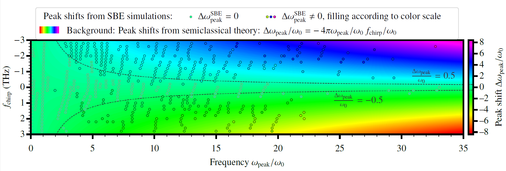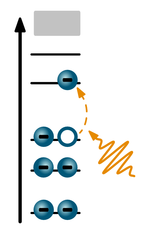
Maximilian Graml
Research projects
Theory of non-integer high-harmonic generation
Applying laser pulses with a driving frequency ω to solids, one observes ultrafast dynamics including high-harmonic generation with frequencies n*ω (n ∈ ℕ). We use our open-source software package CUED [1] to investigate the high-harmonic emission spectrum emitted by the surface of the topological insulator Bi2Te3. Currently, we are further exploring the continuous shift of a high-harmonic order to arbitrary non-integer multiples of the driving frequency r*ω (r ∈ ℝ) beyond Ref. [2] by varying the shape of the driving pulse. We have developed an analytical formula for the shift of high-harmonics frequencies while changing the shape of the laser pulse. We have compared the analytical formula to numerical data finding quantitative agreement, thus validating the formula [3].

 Bethe-Salpeter equation in CP2K
Bethe-Salpeter equation in CP2K
Using density-functional theory (DFT) and many-body perturbation theory within the GW approximation, electronic band structures and quasiparticle energies in molecules can be computed to model a wide range of materials, e.g. electronics, pharmaceuticals or cosmetics. The GW-Bethe-Salpeter equation (GW-BSE) approach further enables the accurate computation of optical properties corresponding to excitations of the system, e.g. providing a means to find potential candidates for novel photovoltaics and other electronics. We are currently working on an implementation of the BSE in the open-source package CP2K to take advantage of the available low-scaling GW methods [4,5].
[1] J. Wilhelm et al.: Semiconductor Bloch-equations formalism: Derivation and application to high-harmonic generation from Dirac fermions, Phys. Rev. B 103, 125419 (2021).
[2] C. P. Schmid et al.: Tunable non-integer high-harmonic generation in a topological insulator, Nature 593, 385-390 (2021).
[3] M. Graml et al.: Theory of non-integer high-harmonic generation in a topological surface state, Physical Review B 107, 054305 (2023)
[4] J. Wilhelm et al.: Toward GW calculations on thousands of atoms, J. Phys. Chem. Lett. 9, 306-312 (2018).
[5] M. Graml et al.: Low-Scaling GW Algorithm Applied to Twisted Transition-Metal Dichalcogenide Heterobilayers, J. Chem. Theory Comput. 20, 2202–2208 (2024).
Short CV
| 11/2023 | Research award of the Brigitta and Oskar Braumandl foundation |
| since 10/2023 | PhD student, University of Regensburg |
| 10/2017 - 09/2023 | Studies of Physics, University of Regensburg, M.Sc. in 08/2023; B.Sc. in 01/2021 |
Teaching
| WiSe 2022/2023 | Classical Mechanics (teaching assistant) |
| WiSe 2020/2021 | Classical Mechanics (teaching assistant) |
| WiSe 2019/2020 | Mathematische Methoden (teaching assistant) |

